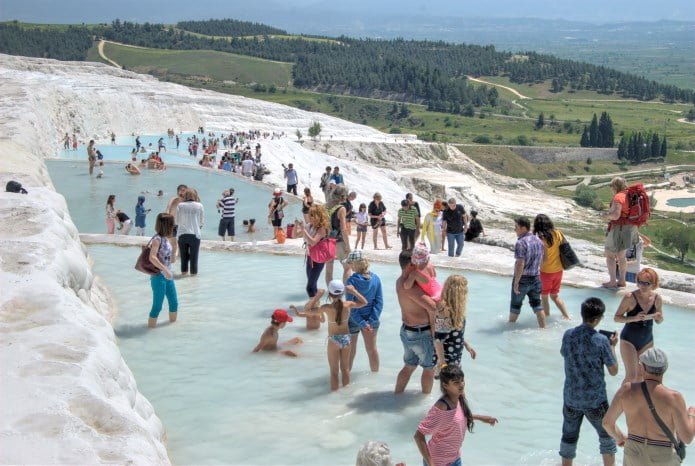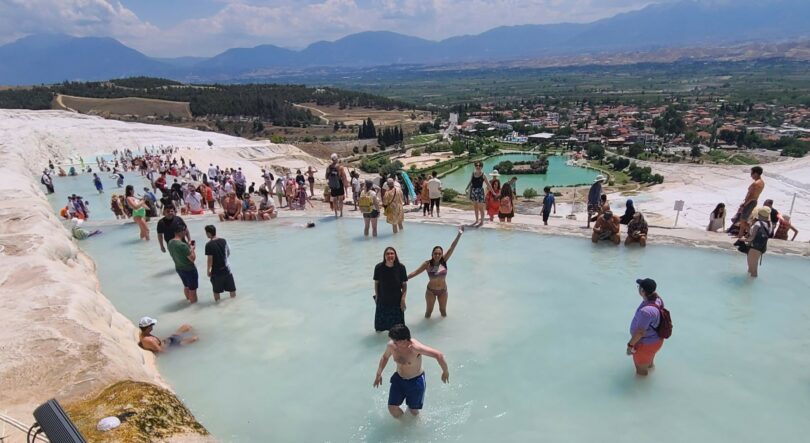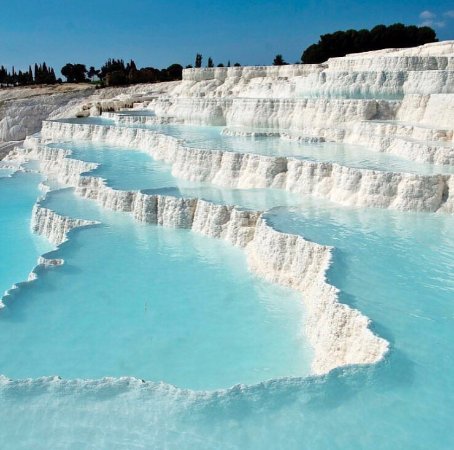Where History Bathes: Hike Pamukkale's Ancient Pools

Pamukkale is one of the most iconic destinations in Turkey, known for its stunning landscape and ancient history. The highlight of this unique natural wonder is the series of terraces known as the Ancient Pools, filled with crystal-clear, mineral-rich water. Exploring these pools is a must-do experience for anyone visiting Pamukkale. In this blog post, we will take you on a virtual journey to discover the beauty and significance of Pamukkale's Ancient Pools.
Overview of Pamukkale's Ancient Pools
The Ancient Pools of Pamukkale are a collection of terraces formed by flowing water rich in mineral content. The terraces give the appearance of pure white cotton or snow, which gave the place its name, as "Pamuk" means cotton in Turkish. As you make your way up the terraces, you will find beautiful shallow pools of warm water, ranging in temperatures. These pools are visually striking and provide a unique opportunity for a relaxing and therapeutic bath.
When walking barefoot on the travertine terraces, you can truly appreciate the sensation of the warm water flowing over your feet. The water is believed to have healing properties and is said to be beneficial for various skin conditions and ailments. Soaking in these natural pools is a treat for the senses and a rejuvenating experience for the body and mind.
Significance of the historical site
Besides its natural beauty, Pamukkale is also home to the ancient city of Hierapolis, founded in the 2nd century BC. Hierapolis was renowned for its thermal baths, and the Ancient Pools of Pamukkale were an integral part of this ancient city. It is said that the people of Hierapolis used these pools for relaxation and healing.
The combination of the natural wonders and historical significance makes Pamukkale a UNESCO World Heritage Site. It attracts visitors from around the world who come to admire the unique landscape and immerse themselves in the history of this ancient city.
A visit to Pamukkale's Ancient Pools is a once-in-a-lifetime experience that combines natural beauty, relaxation, and historical significance. So, add this remarkable destination to your travel bucket list and indulge in the stunning views and healing waters of the Ancient Pools.

The Formation of Pamukkale
Geological process of the terraces
Have you ever wondered how the terraces of Pamukkale were formed? A fascinating geological process has shaped this unique landscape over thousands of years. The flowing water rich in mineral content forms the terraces, which deposit calcium carbonate as it cascades down the hillside.
Over time, this accumulation of calcium carbonate has created the stunning terraces we see today. The water that flows down the hillside is sourced from natural hot springs, which are abundant in this region. As the water flows, it cools down, allowing the calcium carbonate to precipitate and form the terraces.
Formation of travertine rocks
Travertine rocks are a key component of the terraces in Pamukkale. These rocks are formed due to the high concentration of calcium carbonate in the water. When the water reaches the surface and comes into contact with the air, it releases carbon dioxide, causing the calcium carbonate to solidify and form travertine.
Over time, layer upon layer of travertine accumulates, resulting in the distinctive white colour of the terraces. The travertine rocks are porous, allowing the water to flow through them and create the shallow pools that are the highlight of Pamukkale's Ancient Pools.
Understanding the geological process behind the formation of Pamukkale gives us a deeper appreciation for this natural wonder. It's a testament to the power of nature and how it can sculpt breathtaking landscapes over time. So, when you visit Pamukkale, take a moment to marvel at the intricacies of its formation and soak in the beauty of these ancient terraces.

Ancient Hierapolis
History and significance of Hierapolis
When you explore Pamukkale, you'll also have the opportunity to visit the ancient city of Hierapolis. This city has a rich history that dates back to the 2nd century BC. The King of Pergamon founded it, and later became a significant Roman city.
Hierapolis, built around the natural hot springs flowing into Pamukkale, was known for its healing properties. People would visit Hierapolis to take advantage of the therapeutic properties of the hot springs, believing that they could cure various ailments.
Archaeological ruins in Hierapolis
Today, you can witness the fascinating archaeological ruins of Hierapolis. The city was home to various structures, including the Grand Theatre, the Temple of Apollo, and the Necropolis. The theatre is particularly impressive, with its capacity to seat over 12,000 people.
Exploring the ruins gives you a glimpse into the daily life of the ancient inhabitants of Hierapolis. You can see the remnants of houses, streets, and a well-preserved Roman bath complex. It's a must-visit for history enthusiasts and anyone interested in experiencing the wonders of the past.
Visiting Pamukkale and exploring the ancient city of Hierapolis is a truly unique experience. From the terraces' natural beauty to the ruins' rich history, there's something for everyone to appreciate. So make sure to include Pamukkale and Hierapolis on your travel bucket list!

Exploring the White Terraces
Experiencing the natural beauty of Pamukkale
Have you ever dreamt of walking on beautiful white terraces? Pamukkale offers you just that! As you step foot on the terraces, you'll be mesmerized by the stunning white landscape the flowing water rich in mineral content creates. The cascading water deposits calcium carbonate over thousands of years, forming the unique terraces we see today. It's truly a sight to behold.
As you wander through the terraces, you can appreciate the natural wonders surrounding you. The tranquil pools, with their crystal-clear blue water, invite you to take a dip and relax. The travertine rocks, porous and full of character, create shallow pools where you can immerse yourself in the therapeutic waters. It's an experience like no other, filled with wonder and awe.
Guided tour options
Consider joining a guided tour to make the most of your visit to Pamukkale. These tours are designed to provide in-depth knowledge about the formation of the terraces and the history of the ancient city of Hierapolis. Knowledgeable guides will take you through the terraces, explaining the fascinating geological processes behind their creation. They will also lead you through the archaeological ruins of Hierapolis, bringing its rich history to life.
With a guided tour, you'll learn about the significance of Hierapolis as a healing centre where people believe in the therapeutic properties of the natural hot springs. You'll get to explore the grand theatre, walk the streets of the ancient city, and even see a well-preserved Roman bath complex. The guided tour will enhance your experience and give you a deeper understanding of this remarkable destination.
So, come and explore the white terraces of Pamukkale. Immerse yourself in the natural beauty, learn about its formation, and delve into the history of Hierapolis. It's an adventure that will leave you with memories to cherish forever.

Pamukkale Pools
Features and unique characteristics of the thermal pools
Are you ready to immerse yourself in the stunning thermal pools of Pamukkale? These pools are truly one-of-a-kind, with their unique characteristics that make them a must-visit destination. The flowing water, enriched with minerals, creates a mesmerizing white landscape that is simply breathtaking.
Walking through the terraces, you'll be amazed by the tranquil pools of crystal-clear blue water. These pools are formed by the porous travertine rocks, which have a distinct character and add to the beauty of the landscape. You can take a dip in these shallow pools and experience the therapeutic properties of the warm, mineral-rich water. It's a truly rejuvenating experience that will leave you feeling refreshed and invigorated.
Benefits of bathing in the pools
Bathing in the thermal pools of Pamukkale is not just a luxurious experience but also offers numerous benefits for your mind, body, and soul. The warm water is known to have healing properties that can help alleviate various ailments, including joint and muscle pain, skin conditions, and even respiratory problems.
Immersing yourself in the pools can also help reduce stress and promote relaxation. The serene surroundings and the soothing water will help you unwind and rejuvenate your senses. It's the perfect way to escape from the hustle and bustle of everyday life and reconnect with nature.
The thermal pools of Pamukkale are not just a natural wonder but also a destination that offers a unique and enriching experience. So, don't miss the opportunity to explore these amazing pools, bathe in their rejuvenating waters, and revel in the beauty of this remarkable destination.

Cultural Heritage of Pamukkale
Discovering the cultural significance of Pamukkale
Are you ready to explore the rich cultural heritage of Pamukkale? Beyond its stunning thermal pools, this destination holds a deep historical and cultural significance. Delve into the past and uncover the stories and traditions that have shaped this remarkable place.
One of the highlights of Pamukkale is the ancient city of Hierapolis, which was built on top of the white terraces. This ancient city was a thriving hub of civilization and a centre for trade, art, and religion. As you walk through the ruins, you can still witness the remnants of its glorious past.
Another symbol of the cultural heritage of Pamukkale is the well-preserved Roman theatre. This impressive structure once hosted grand performances and events and is a testament to the architectural and artistic skills of the ancient Romans.
Local traditions and customs
Immerse yourself in Pamukkale's local traditions and customs to truly experience this place's essence. The local community takes pride in their cultural heritage and continues to preserve their customs for future generations.
One such tradition is the art of carpet weaving, an ancient craft passed down through generations. You can visit local workshops to witness the intricate process of creating these beautiful carpets and even try weaving.
The people of Pamukkale also celebrate various festivals throughout the year, showcasing their vibrant traditions. From music and dance performances to traditional costumes and delicious local cuisine, these festivals offer a glimpse into the local way of life and create unforgettable memories.
So, don't miss the chance to immerse yourself in not just the natural wonders but also the cultural heritage of Pamukkale. Explore the ancient ruins, witness the local traditions, and let this destination leave a lasting impression on your heart.
Preservation and Conservation Efforts
Steps taken to protect and preserve Pamukkale
Are you curious about the efforts being made to protect and preserve the cultural heritage of Pamukkale? Let's explore the steps that have been taken to ensure the longevity of this remarkable destination.
-
Conservation of Hierapolis: Extensive restoration work has been carried out on the ruins of Hierapolis to ensure their preservation. These efforts have included stabilizing structures, protecting delicate artefacts, and implementing strict regulations to prevent damage from visitors.
-
Sustainable Tourism Practices: The local authorities have implemented sustainable tourism practices to minimize the environmental and cultural sites' impact. This includes limiting the number of visitors allowed in certain areas, promoting responsible tourism behaviour, and educating visitors about the importance of preservation.
-
Collaboration with UNESCO: Pamukkale has been recognized as a UNESCO World Heritage Site, which has led to increased international support and funding for conservation efforts. This partnership has helped in the development of preservation plans and the implementation of best practices.
Challenges faced in preserving the site
Despite the ongoing efforts, preserving Pamukkale's cultural heritage comes with its fair share of challenges. Let's explore some of the obstacles faced in safeguarding this unique destination.
| Challenge | Description |
|---|---|
| Natural Erosion | The natural processes of erosion and weathering pose a constant threat to the terraces and ruins of Pamukkale. Measures have been taken to control the flow of water and limit human access to sensitive areas. |
| Tourism Pressures | The popularity of Pamukkale as a tourist destination can put a strain on the fragile ecosystem and contribute to the wear and tear of the cultural sites. Strict visitor management and guidelines are implemented to minimize negative impacts. |
| Climate Change | The changing climate and extreme weather events can have adverse effects on the natural and cultural features of Pamukkale. Adapting to these changes and implementing measures to mitigate potential damage is a significant challenge. |
Despite these challenges, continuous efforts are being made to protect and preserve the cultural heritage of Pamukkale. By respecting the rules and regulations, supporting sustainable tourism practices, and spreading awareness about the importance of preservation, we can all play a role in safeguarding this extraordinary destination for future generations.

Visitor Information
Practical tips and information for visitors
Are you planning a visit to Pamukkale? Here are some practical tips and information to help you make the most of your trip:
-
Dress appropriately: As Pamukkale is a cultural and historical site, it is important to dress modestly out of respect for the local customs. Wear comfortable clothing and footwear, as you will walk on uneven surfaces.
-
Stay hydrated: The temperatures in Pamukkale can get quite high, especially during the summer months. Remember to bring a water bottle to stay hydrated throughout your visit.
-
Sun protection: The sun can be intense in Pamukkale, so protecting yourself from harmful UV rays is important. Wear sunscreen, a hat, and sunglasses to shield yourself from the sun's rays.
-
Follow the rules: Pamukkale is a protected site, and regulations are in place to ensure its preservation. Please follow the instructions given by the authorities and respect any restricted areas or signage.
Entry fees, opening hours, and regulations
-
Entry fees: There is an entry fee to access Pamukkale, which helps support the preservation and maintenance of the site. The fee varies depending on whether you are a local or international visitor. Check the official website or inquire at the ticket office for the latest fees.
-
Opening hours: Pamukkale is open to visitors throughout the year. However, the timings may vary depending on the season. It is recommended to check the official website or contact the visitor centre for the most up-to-date opening hours.
-
Photography regulations: Photography is allowed in most areas of Pamukkale. However, there may be some restrictions on the use of tripods or professional photography equipment. Please be respectful of other visitors and do not obstruct any pathways or views while taking photographs.
-
Guided tours: If you prefer a guided experience, tour operators that offer guided tours of Pamukkale are available. These tours can provide valuable insights into the history and significance of the site.
Remember to plan your visit and adhere to the regulations in place to ensure the preservation of Pamukkale for future generations. Enjoy your trip!

Personal recommendations for future visitors
Are you planning a visit to Pamukkale? Here are some personal recommendations to help you have an amazing trip:
- Take your time: Pamukkale is a unique and stunning destination, so allocate enough time to fully explore and appreciate its beauty. Rushing through the site may cause you to miss some hidden gems.
- Arrive early: The site can get crowded, especially during peak tourist seasons. To avoid large crowds and long queues, try to arrive early in the morning when the site opens. This will allow you to explore at your own pace and take beautiful photos without too many people in the background.
- Bring swimwear: One of the highlights of Pamukkale is the thermal pools, where visitors can enjoy a relaxing soak. If you wish to dip in these pools, don't forget to bring your swimwear and a towel. The water is warm and rich in minerals, offering a unique bathing experience.
- Try local cuisine: Don't miss the chance to indulge in the delicious Turkish cuisine in Pamukkale. There are plenty of restaurants and cafes in the surrounding area where you can taste authentic dishes such as kebabs, baklava, and Turkish tea.
- Be mindful of your surroundings: Pamukkale is a natural wonder that needs to be protected. Please refrain from touching or damaging the travertine terraces, as they are fragile and susceptible to erosion.
By following these recommendations, you will have a memorable and enjoyable visit to Pamukkale. Don't forget to capture the breathtaking landscapes and create beautiful memories!
